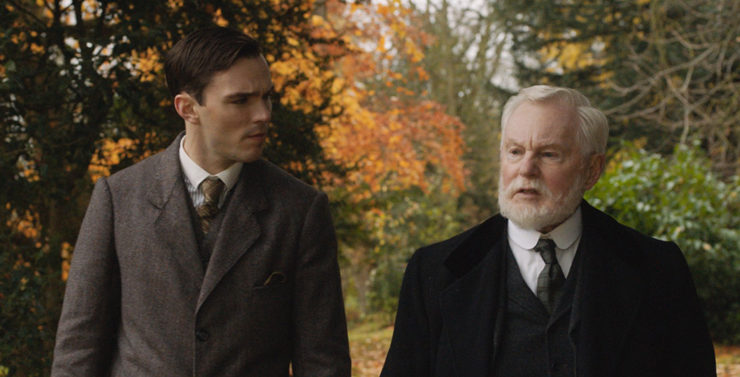Tolkien, the new biopic which depicts moments of John Ronald Reuel’s most formative years is in theaters now, and so I’m here to talk and/or gush about it, praise it, even critique it—but the latter only lightly, because I liked it quite a lot. Above all, I’d like to frame it properly, to tell you what it is and what it isn’t. I would say a spoiler warning is in order, but…really? This is J.R.R. Tolkien. The man ate spoilers for breakfast. And then again for second breakfast.
So the chief questions are: Who is this film for? Who will enjoy it the most? And did Ronald and Edith really throw sugar cubes onto the hats of restaurant patrons? Read on and I’ll tell you.
Let’s start with an analogue. Tolkien is to the professor’s actual life as Peter Jackson’s The Lord of the Rings trilogy is to the book it’s based on. Which is to say, it was made by people who hold great respect for the twentieth century’s greatest author, as is obvious in any interview with director Dome Karukoski. The filmmakers clearly wish to honor to Tolkien’s memory and his work, but the experience of the film is not the same thing as viewing the real man’s life or reading his books. Of course not; it’s a movie!
Now, if you expect a biopic in 2019 to match the life it’s based on beat by beat, then of course you will be disappointed. Some Tolkien purists have probably already decided to dislike this film simply on principle. After all, the Tolkien Estate has disavowed it, they will insist—which, yes, it has, but that just means that it had no involvement in the film’s production. Just as the Estate has “disavowed” every single film adaptation of J.R.R.’s works thus far. It’s no biggie. That’s just how the Tolkien Estate rolls (for now). You don’t even need to go in with low expectations, because the film crackles with energy, humor, and pithy statements delivered without a hint of pretense. Frankly, I think Tolkien, in the very, very least, is an excellent conversation starter on the topic of the man and his vast legendarium.
From the get-go, we’re shown some of the people and places that influenced his imagination, like the pastoral but all-too-brief glimpse we get of the Sarehole countryside of his childhood (*cough* Shire! *cough*).
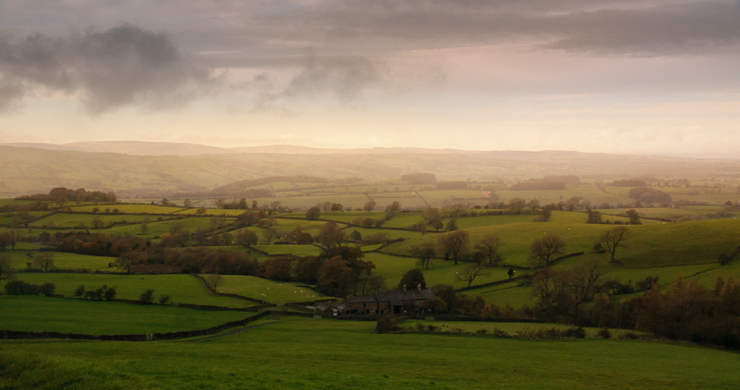
Tolkien does move at a breakneck pace, though, and that’s my chief criticism. It starts with John Ronald and his brother, Hilary, having already moved to England from where they were born in South Africa. Their father has already passed, and we move speedily on to the momentous and tragic loss of his mother. Less time is spent on Mabel Tolkien than I would have liked, considering the massive rippling effect both her short life and death had on real-life Tolkien. It comes up once or twice later in the film, but somehow that doesn’t feel like enough.
In contrast, in his excellent book on Tolkien, biographer Humphrey Carpenter tells it like this:
And certainly the loss of his mother had a profound effect on his personality. It made him into a pessimist.
Or rather, it made him into two people. He was by nature a cheerful almost irrepressible person with a great zest for life. He loved good talk and physical activity. He had a deep sense of humour and a great capacity for making friends. But from now onwards there was to be a second side, more private but predominant in his diaries and letters. This side of him was capable of bouts of profound despair. More precisely, and more closely related to his mother’s death, when he was in this mood he had a deep sense of impending loss. Nothing was safe. Nothing would last. No battle would be won for ever.
Anyone who’s read The Lord of the Rings or The Silmarillion knows how intrinsic underlying sorrow is to Tolkien’s world, even amidst great beauty and unquenchable hope.
But there is still much to appreciate about this biopic. Sure, it dramatizes what might not have actually been so dramatic, it fills in some blanks, and it messes with some of the chronology. Yet it also brings to life some of those events, and gives expressive faces to the names, that come up in otherwise dry Tolkien biographical summaries. Throughout, we’re given visions that are meant to show the young man’s imagination at work. From his glimpses of wraithlike shapes moving among dying soldiers, to dragons spewing fire on the battlefield, to a looming Dark Lord on the horizon, we see evil personified through his eyes.
Is that dragon supposed to Smaug? Not necessarily, no. And are those Nazgûl? Not exactly, no. It’s much too soon for that story. And is that Sauron or Melkor we see? I think maybe, yes. Either/or, at this point.

Okay, so here’s what this film doesn’t give us:
- A full rundown of Tolkien’s life from beginning to end. We don’t get to the Inklings; the famous Eagle & Child pub is name-dropped only once.
- Tolkien’s overall experiences in the First World War. In fact, we only see him at the infamous Battle of the Somme, and then only on what seems to be his last day or two before succumbing to trench fever and getting sent home. The war scenes form a kind of frame story in the film, as it jumps from the trenches to the past and back again.
- Many parallels between Tolkien’s life and The Lord of the Rings itself, for which I’m glad. Sure, there are some key words and concepts—a fellowship, a ring, defiance against dark forces—but there’s nothing too overt or cringe-worthy. (Yes, there’s a batman in the trenches who sure gives Second Lieutenant Tolkien the Samwise treatment, and in the film the guy is named Private Sam, but it’s carried no further than that.)
- Much about Tolkien’s faith. It’s established that he’s Catholic and that Edith isn’t (a point of contention for Tolkien’s guardian, Father Francis Morgan), but that’s about it. It’s disappointing that this immense part of his life must fall by the wayside, but it’s surely a challenging concept to visually portray.
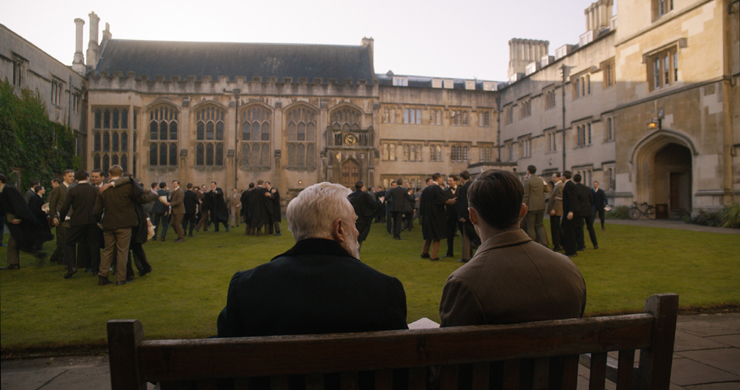
But wait—here’s what this film does give us:
- Our favorite professor being a real person, not just the familiar icon clad in tweed and smoking a pipe in a study—that’ll come eventually. John Ronald is played by X-Men/Mad Max: Fury Road star Nicholas Hoult, and while I personally had a hard time superimposing his face onto the real author’s in my head, the problem is simply a visual one. He did a fine job acting the part—looking obsessive, speaking in quick bursts, and emoting alternating grief and joy—even if he enunciated way more clearly than the real life Tolkien seemed to have done.
- Highlights of Tolkien’s life leading up to his conception of The Hobbit, with a strong emphasis on his obsession with words and language, how this preoccupation led him to study Old English (among other languages), and ultimately to philology. Even though plenty of little licenses are taken in the process.
- His boyhood friendships and the formation of the T.C.B.S., or Tea Club, Barrovian Society at King Edward’s School—a mighty force of literary analysis, philosophy, and art for young Tolkien.
- His meeting and romance with Edith Bratt, a.k.a. his future wife and the woman who inspired the unstoppable Lúthien Tinúviel. She is witty and intelligent, brave and honest, and actress Lily Collins does a worthy job of showing us how Edith could have been both Tolkien’s muse and his foil. Though the mythic Elf princess’s name never comes up, when Edith expresses her frustrations about being confined in her life choices, I couldn’t help but think of the the meaning of Leithian, which means “Release from Bondage.”
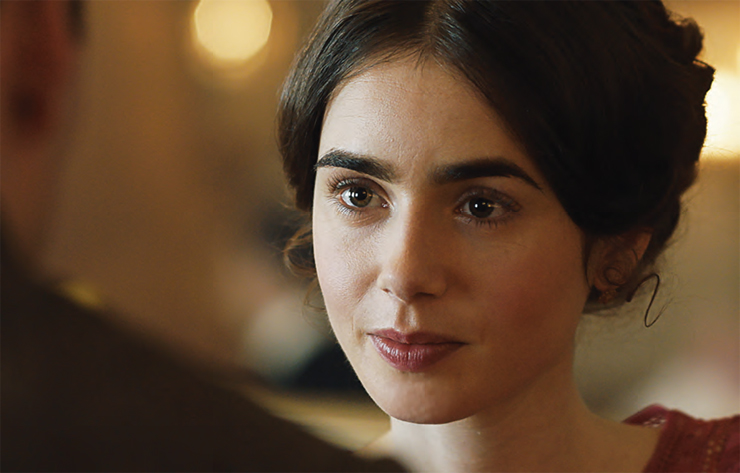
- Ideas to believe in; ideas we can get behind. Like the love that grows between two childhood friends who in time become life partners. Like the unshakable bond of love that can form between male friends (and that’s not nothing; The Lord of the Rings illustrates this in spades). And like the qualities of courage, defiance, and having the conviction to pursue our dreams.
- A slew of great actors, including the young men and women playing the younger versions of the adults (Harry Gilby as Ronald and Mimi Keene as Edith are utterly convincing). Veterans Colm Meaney (as Father Francis) and Derek Jacobi (as Professor Wright) are unquestionably solid, though they’re only got a few scenes each; Jacobi (who’s been in, like, everything) even gets a memorable, fun scene talking about…trees. I was also happy to see Pam Ferris as Mrs. Faulkner, the owner of the boarding house where the orphaned Ronald and his brother stay; Ferris is probably recognized more among Americans for Matilda and maybe Harry Potter and the Prisoner of Azkaban, but I’m also fond of her from the BBC garden-centric murder mystery show, Rosemary & Thyme.
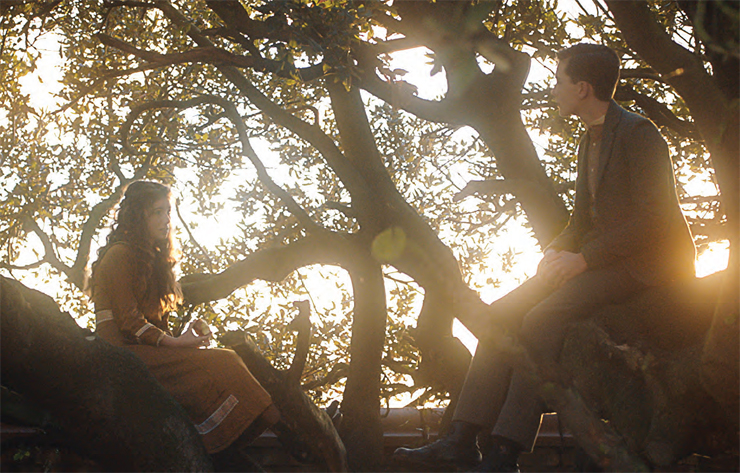
As a biographical film, I will say again that it sure was rushed. Granted, you can only fit so much into a reasonable run-time, but the pace still leaves you feeling like the whole thing is merely an extended movie trailer for the real thing. And maybe that’s okay, because the story itself is worth learning, beyond than what any movie can offer. Ultimately, Tolkien is a crash course in the man behind the papers and pipe. If you haven’t read any of his biographies then this film will give you the basics (with some license taken)—or, better still, it might inspire you to seek them out. I absolutely do recommend the latter.
The film could have covered more ground and tried to touch on more seminal events, or at least linger more on the moments we do see. Instead it zooms in on some of those concepts that had an immense an impact on Tolkien’s life: the beauty of language (the union of both sound and meaning), and deep friendship. A fellowship isn’t just a party of adventurers thrown together by Elrond in a fictional world. In fact, the term as it’s used here isn’t even something you’d apply to the nine Companions of the Ring. It’s applied to John Ronald and the other members of the T.C.B.S, who in the film are a group of delightfully nerdy friends who band together and wish to change the world.
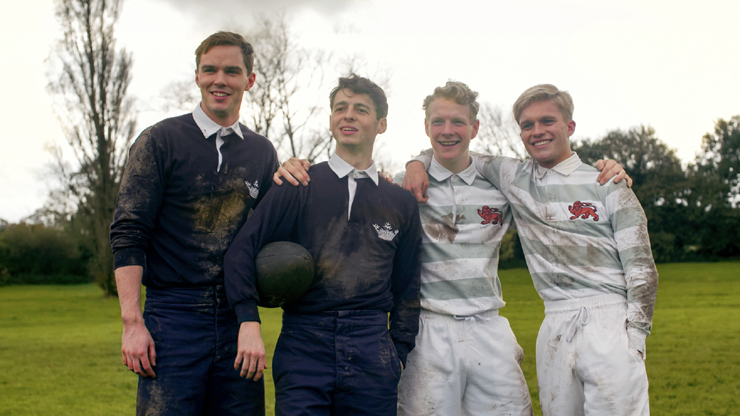
Given their good-natured ribbing and general shenanigans, there is definitely something of Pippin and Merry reflected in them all, akin to four hobbits of the Shire, each from a different background but the same land, getting caught up in big events whose scope they can scarcely imagine or fully grasp. Now, the real life T.C.B.S. numbered as many as nine—it was a fluctuating membership at any given time—but in the film there are only four kids:
- John Ronald Tolkien is indisputably the nerdiest, bringing his love of books and language and stories to the club. It is he who introduces the Old Norse name Helheimr to them, and it quickly becomes as a battle cry, a term of defiance. The applicability grows with each utterance.
- Robert Gilson, son of the school’s headmaster, brings painting and Renaissance art appreciation to the table. In real life he was described as “quiet-spoken but witty,” but in the film he’s more of a brash ringleader.
- Christopher Wiseman is the musician of the club, a published composer, and a friendly rival to Tolkien, and in the end he’ll also be the only other member of the T.C.B.S. who survives the war.
- Geoffrey Smith is younger than the rest (and in real life was the last to join the group), but is welcomed in for his knowledge of poetry and literature—and it’s clear that Smith helped kindle Tolkien’s interest in poetic verse.
Each one of these companions is given his own little arc in the film—most memorably, perhaps, is Geoffrey Smith. He’s the “gentle” soul who comforts Tolkien when he believes he’s lost Edith to someone else. Smith is the ultimate friend, the Faramir, the Sam, the kind of friend we should all be so lucky to have, and in the Battle of the Somme, he’s the one person Tolkien is desperate to find. There is some focus placed on Geoffrey Smith’s estrangement from his family—for their inability to accept his passions and pursuit of poetry—and it is difficult to pinpoint what the film was aiming to say about him. But ultimately it’s open-ended, and it made me keenly interested in seeking out the real man’s work (published posthumously due to Tolkien’s encouragement).
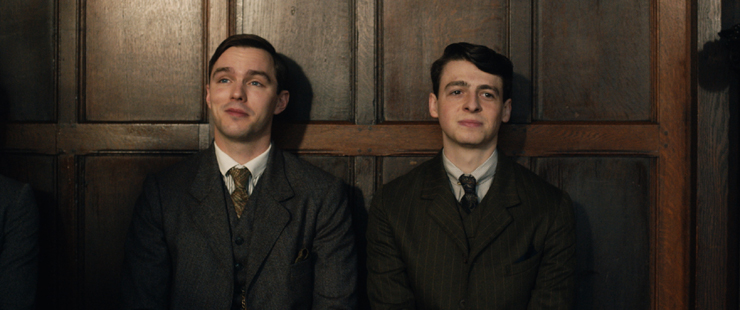
Now for the oliphaunt in the room, though maybe it’s a small one.
It’s unclear what rights, if any, the filmmakers had to work with when it came to referencing J.R.R. Tolkien’s actual creations. There was not a single character or place named in the movie that’s unique to his legendarium. We see Ronald stumble upon the word Middle-earth in a book (which is true, he found it in a fragment from the Old English poet Cynewulf) and he later speaks the name Éarendel while looking up into the stars, but that’s about it. Neither word had he coined or invented. Even the word “hobbit” is mostly just mouthed at the end of the film.
The fact is that Tolkien’s earliest writings concerning Middle-earth—the fall of Gondolin, and the Children of Húrin, and of course Beren and Lúthien—did come about during the period of time covered in the film.
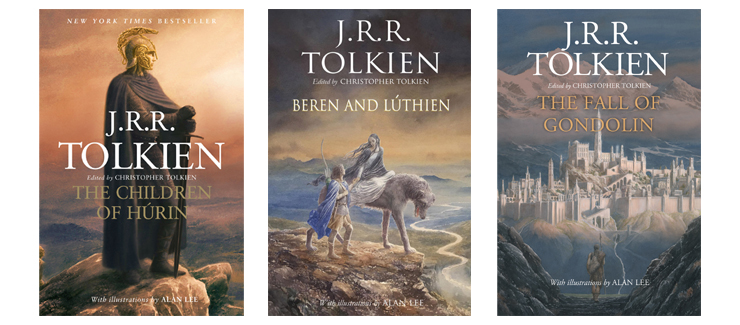
Yet when the movie jumps forward in time we see Edith admonishing Ronald for having stopped writing what he was passionate about. As if he hadn’t still been fiddling away with his Elvish languages and mythic tales all along. (He was, in the very least, already telling his own stories to his children, to say nothing of the texts that would someday comprise The Book of Lost Tales.) In the film, with Edith’s coaxing, Tolkien is steered back into storytelling, which leads him to eventually pen his famous opening line:
In a hole in the ground there lived a hobbit.
Of course, this is really just a mild complaint for us Tolkien nerds. Only if you already know the professor’s life story does it feel like the filmmakers’ real-life legal constraints may have hemmed in the plot somewhat. It’s a shame, if it’s really just about not having rights, but what else can they do? Then again, by the time we reach Tolkien’s recovery from the war, when those stories would be truly begin taking shape, the film is also winding down. This isn’t a story about Tolkien’s life achievements, nor his fictional world taking shape—just the events that shaped him.

All that said, what the film does address it addressed very well, and it does so with integrity. Tolkien’s romance with Edith is enchanting, to say nothing of the warrior-camaraderie he shares with his friends. They laugh and debate, sharing their passions and their own works, and generally get along like the best of schoolmates. It’s infectious. Strangely, the film’s press descriptions refer to these friends as “a group of fellow outcasts,” but that’s surely overstating it. In King Edward’s school, the T.C.B.S. boys were more like high-brow Frasier and Niles Crane types than like rugby hooligans. They drink tea in the library, have scholarly disputes in the tea-shop, and recite poetry to one another. Though they did engage in some amount of troublemaking—there’s a scene in the film involving a commandeered bus that was apparently far more rabble-rousing in real life than is shown in the film.
Circling back to my original questions: Who is this film for? It’s for absolutely anyone, fans of all stripes. Who’ll enjoy it most? Probably casual Tolkien fans who won’t notice the creative licenses taken. But honestly, it’s worth falling under the movie’s spell for a little while. If you’re historically minded, you might quibble a little bit, too, but it’s still a worthwhile adventure.
And as for those thrown sugarcubes…yes, that happened in real life. Mostly. From Humphrey Carpenter’s biography, it actually sounds like this was an activity those two crazy kids took part in often, or least not just once. Ronald and Edith would sit at the balcony of tea-shops and toss sugar-lumps down onto the hats of passers-by, “moving to the next table when the sugar-bowl was empty.” Tolkien the rascal! Tolkien the scamp!
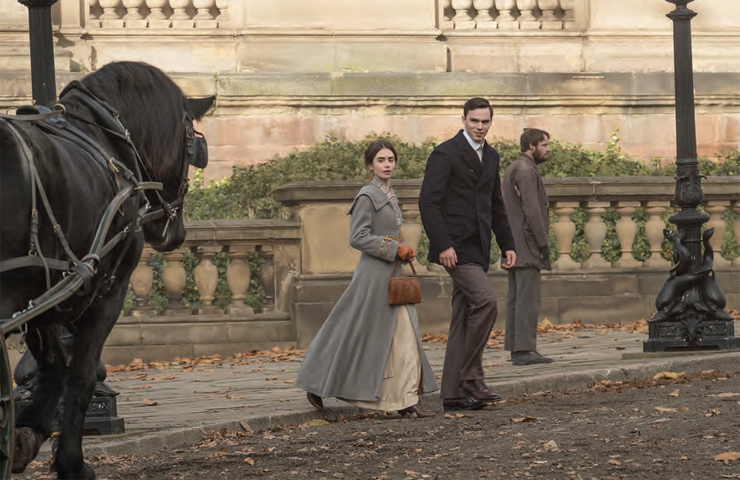
If Tolkien the film has the effect that I hope it does, inspiring new interest in the man himself (and thereby his writing), I definitely recommend the following works:
- J.R.R Tolkien: A Biography is the quintessential account of Tolkien’s life, written by biographer Humphrey Carpenter who met with the professor himself (the opening chapter is a description of visiting Tolkien and Edith at their house; it’s delightful).
- J.R.R. Tolkien: Author of the Century, the work of medievalist Tom Shippey (whose academic career has mirrored Tolkien’s own), cuts to the heart of the professor’s work as a storyteller. (Here’s an interview with Shippey on The Prancing Pony Podcast!)
- Tolkien and the Great War by John Garth is a more recent work, specifically addressing Tolkien’s part in the First World War and how it influenced his earliest tales. (Here’s an interview with Garth on The Prancing Pony Podcast, too, specifically about this book.)
Jeff LaSala is responsible for the long-winded Silmarillion Primer, but regrets it not at all. Tolkien geekdom aside, Jeff wrote a Scribe Award–nominated D&D novel, produced some cyberpunk stories, and now works for Tor Books. He sometimes flits about on Twitter.










